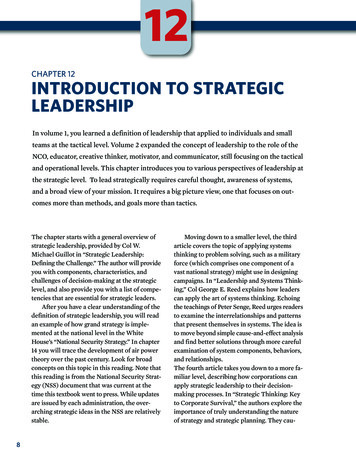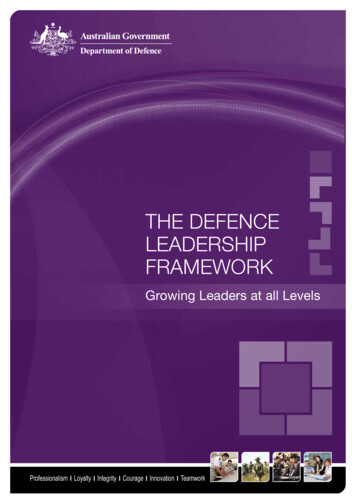
Transcription
StrategicLeadershipUnited States army war college
STRATEGIC LEADERSHIPPrimer for Senior Leaders4th EditionTom Galvin (Ed.)Craig BullisDale Watson (Ed.)Douglas WatersSilas MartinezNate HunsingerAndrew HillPete SniffinKristin BehfarMaurice SiposDouglas DoudsMichael HosieForeword by John S. KemDepartment of Command, Leadership, andManagementSchool of Strategic LandpowerU.S. Army War College, Carlisle, PA
II Strategic Leadership: Primer for Senior Leaders*****This publication is subject to Title 17, United States Code, Sections101 and 105. It is in the public domain and may not be copyrighted.*****Comments pertaining to this book are invited and shouldbe forwarded to the Department of Command, Leadership,and Management, School of Strategic Landpower, U.S. Army WarCollege, 122 Forbes Avenue, Carlisle, PA 17013-5240.*****All Strategic Studies Institute (SSI) and U.S. Army WarCollege (USAWC) Press publications may be downloaded free of chargefrom the SSI website. Hard copies of certain reports may also beobtained through the U.S. Government Bookstore's website at https://bookstore.gpo.gov. SSI publications may be quoted or reprinted inpart or in full with permission and appropriate credit given to theU.S. Army Strategic Studies Institute and U.S. Army War CollegePress, U.S. Army War College, Carlisle, PA. Contact SSI by visitingour website at the following address: https://ssi.armywarcollege.edu/.*****The Practitioner’s Corner is a part of the USAWC Publicationssite reserved for USAWC faculty publications of educational value.These may be quoted or reprinted in part or in full with permissionand credit given to the authors, editors, or departments asappropriate. Visit https://publications.armywarcollege.edu for moreinformation.*****The Strategic Studies Institute (SSI) is the U.S. Army's institute forgeostrategic and national research and analysis. SSI supports theU.S. Army War College (USAWC) curricula, provides directanalysis for Army and Department of Defense leadership, and servesas a bridge to the wider strategic community. SSI studies are publishedby the USAWC Press and distributed to key strategic leaders inthe Army and Department of Defense, the military educationalsystem, Congress, the media, other think tanks and defense institutes,and major colleges and universities.ISBN: 1-58487-782-0
U.S. Army War College IIITable of ContentsTable of Contents . IIIList of Figures . IVForeword . VJohn S. KemPreface . VIITom Galvin and Dale WatsonChapter 1. Leadership at the Strategic Level . 1Silas Martinez and Tom GalvinChapter 2. The Competitive Environment . 13Andrew Hill and Dale WatsonChapter 3. Leading Large Bureaucratic Organizations: TheInternal Environment . 25Kristin Behfar and Dale WatsonChapter 4. Competitive Strategy. 37Andrew A. Hill, Douglas Douds, and Dale WatsonChapter 5. Senior Leader Roles . 49Craig BullisChapter 6. Senior Leader Competencies . 61Douglas WatersChapter 7. Senior Leader Character . 73Maurice L. Sipos, Nate Hunsinger, and Peter R. SniffinChapter 8. Senior Leader Development . 83Michael HosieAfterword . 93Tom GalvinAbout the Contributors . 97
IV Strategic Leadership: Primer for Senior LeadersList of FiguresFigure 1. Aspects of Situational Strength . 78
U.S. Army War College VForewordJohn S. KemLeadership is not easy, and there is no magic recipe forsuccessful leadership. That is why there are so many businessbooks about leaders and leadership traits. In the military, wefocus on leader development at the very beginning of service, inbasic training, and at pre-commissioning . . . every Soldier is aleader. While the principles of tactical leadership are not alwayseasy to do and are certainly aspirational, they are fundamental innature; provide clear vision and intent, develop mutualunderstanding and trust, build cohesive teams that work togetherto achieve decisive results in line with our professional ethic, andprovide orders and guidance that develop initiative and focus onwhat to do and for what purpose, rather than emphasizing thehow.These concepts also apply at more senior levels; however, thechallenges at the strategic-enterprise level are very different. TheArmy inherently knew this but did not formally establish aframework for leadership and command above the direct, tacticallevel until 1987 with the publication of FM 22-103, Leadership andCommand at Senior Levels. The transition from tactical tooperational leadership is far easier than the transition to strategicleadership. That is why the transition to strategic leadership iscentral to our efforts at the U.S. Army War College, and why westrive to “produce strategic leaders and ideas invaluable to theArmy, the Joint Force, and the Nation.” This fourth edition of theStrategic Leadership Primer is designed to facilitate that transitionfor every student.Many leaders who are successful in early-mid career fail tomake the second transition to the enterprise level effectively. Partof their struggle is typically tied to a lack of understanding of thestrategic competitive environment where problems are far morecomplex and previous experiences, while important, areinsufficient to solve multi-domain, joint warfighting levelchallenges. This environment often rewards clarity and punishesthose who wait for certainty.
VI Strategic Leadership: Primer for Senior LeadersIn addition to the increased complexity of large organizations,many leaders fail to understand how leading these organizationsis different from leading at the brigade/battalion level and below.They are prisoners of their experiences. The formal and informalchannels of the organization, the interplay of control,communication, and structure, and how the leader operates (bothinternally and externally) are all different.Larger organizations require strategic leaders with additiveskills, knowledge, and behaviors. One size fits all leadership willnot work. True leaders communicate effectively by reachingacross the organization to every person they work with, adaptingtheir leadership style to them. They lead far more by influence,where empathy, the art of asking questions, the art of story andengagement, and the science and art of forming effective teamsare critical. Instead of being the expert, effective senior leadersbring together and lead teams with expert knowledge andcollaborate internally and externally to develop innovativesolutions. The word solutions is important. It drives the “why.”Success is not just strategic direction through strategic vision andplans; success requires effective enterprise execution andadaptive management—getting both the unit and theorganization from idea to impact.Finally, strategic leaders must exercise moral judgment. Weare the stewards of our profession. We must have the moralcharacter and passion for life-long growth and development.Otherwise, how will we be ready for the difficult art of leadershipon the battlefield—or wherever else the nation demands ourservice. I know this Strategic Leadership Primer will help!John S. KemMajor General, U.S. Army51st Commandant of the U.S. Army WarCollege
U.S. Army War College VIIPrefaceTom Galvin and Dale WatsonMost U.S. Army War College (“War College”) students begintheir resident or distance education programs already havingsignificant knowledge and experience in leadership. If asked, theywould likely present their own personal definitions of it—combining power and influence over others, positive personalitytraits, capacity for developing a vision and leading change,decision making, and other skills, knowledge, and attitudespresent since one’s days as a lieutenant or ensign. However,attaching the word strategic adds particular meaning. It representsthe application of leadership in a context qualitatively differentfrom those familiar to most students—such as direct leadershipover units, organizational leadership in the positions of staffofficer, or operational leadership in combat environments.In the past, the transition to strategic leadership wasconsidered significant and the War College assumed most of itsstudents had little prior experience at the strategic level. WarCollege graduates were far more likely to see the strategicenvironment as foreign. The student body included officers whoexcelled in the standard unit-level career path with onlyoccasional (if any) broadening assignments, and there were fewinteragency students or international fellows attending withthem. Entering the strategic environment required skills andknowledge that students were much less likely to havedeveloped. This became the impetus for the Primer’s 1st Edition of1998. This simple introductory guide to the strategic environmentand competencies of strategic leaders helped students prepare forduties in what was a foreign environment for much of theircareers. The sentiment what got you here won’t get you therepervaded the War College’s approach to educating its students onleadership, and persisted through the first three editions of thePrimer.This 4th Edition takes a different view based on changingdemographics and experiences of incoming War College students
VIII Strategic Leadership: Primer for Senior Leadersand new research in leader development. First, today’s WarCollege students are far more familiar and experienced withstrategic matters and their implications for the defense enterprisethan in the past. Many have experience in heterogeneous units ofmilitary, civilians, and contractors or served extensively in nontraditional unit environments. They have been accustomed toattending professional military education with internationalfellows from around the world and fighting in joint, interagency,and multinational operations.A meta-analysis of development research shows that asleaders successfully advance from junior to senior levels, they donot replace old competencies with new ones. 1 Rather, they adaptand grow their existing competencies while acquiring new onesexperientially based on the leadership context they are in. In otherwords, there is growth both quantitatively and qualitatively. Allleaders, for example, require the ability to analyze theenvironment, think critically, learn, make decisions, andcommunicate with others. Such competencies grow in strengthand scope as the leader moves to higher levels, where moreadvanced skills such as negotiation, consensus building, andframe of reference development become more important.Meanwhile, other competencies are much less salient at the juniorlevels—such as resource and personnel management, envisioningthe future and leading change, and political competence—butbecome critical at the strategic level. Leaders must develop thosecompetencies at more accelerated paces.Alignment of one’s competencies to the demands of theenvironment is vital. The consequences for strategic leadersfailing to develop and grow the right competencies are clear. Theyare unable to adapt to the strategic environment, are unpreparedmentally and spiritually to make decisions, narrow their scopeand attention to familiar and comfortable matters, and are liableto default to ‘tried and true’ methods appropriate for more juniorlevels.1 Troy V. Mumford, Michael A. Campion, and Frederick P. Morgeson, "The LeadershipSkills Strataplex: Leadership Skill Requirements Across Organizational Levels," TheLeadership Quarterly 18, no. 2 (2007): 154-166.
U.S. Army War College IXThe pursuit of this alignment is an individual journey. Thereare broad classes of competencies common among successfulstrategic leaders, but each leader develops them in his or her ownway. This edition of the Primer is a guide along that journey. Itbegins with an understanding of how the environment differsfrom the organizational to the strategic levels, then follows withthe differences in roles and competencies that strategic leadersrequire. It concludes with a way ahead for leaders to establishtheir own professional development plans. It is useful as aresource for both War College students to learn about entry intothe strategic level, and for graduates immersed in theenvironment who need a tool to get past the tyranny of the inboxand think longer-term, as strategic leaders should.There are seven chapters in the 4th Edition. Chapter 1. Leadership at the Strategic Level. SilasMartinez and Tom Galvin define the key terms of thisPrimer. With Dwight Eisenhower as an exemplar, theydefine strategic leadership and describe key differencesfrom the organizational context (e.g., significantlyincreased complexity and importance of leading in teams)prevalent through the rest of the Primer. They also definetwo strata of leaders who practice strategic leadership –the strategic leaders who serve the enterprise in executivelevel capacities, and senior leaders composed of militaryand civilian leaders from the grades of O-6/GS-15 andabove who run the enterprise on a daily basis.The next three chapters present the strategic environmentwith two chapters on the external and internal contexts,integrated in the following chapter on competitive strategy. Theincreased complexity of the strategic environment and thepressures it induces on leaders will be a constant theme. Chapter 2. The Competitive Environment. Andrew Hilland Dale Watson present the external context of theorganization, describing the environment as dynamic,complex, competitive on many fronts, and characterizedby deep uncertainty. The ultimate competition formilitary organizations may be on the battlefield, but thatis far from the only form of competition senior leaders
X Strategic Leadership: Primer for Senior Leadersface. Leaders must reconsider ‘winning’ as the goal, as inthis environment, there are no ‘winners.’ Chapter 3. Leading Large Bureaucratic Organizations.Kristin Behfar and Dale Watson present the internalcontext of the defense enterprise, which is very large andcomplex. Very large organizations experience naturaltensions such as long-term goals versus short-term needsthat leaders must balance while also navigating acomplicated network of formal and informalorganization. What are the levers available to leaders toaccomplish the organization’s mission, improveorganizational performance, and sustain membercommitment? Chapter 4. Competitive Strategy. Andrew Hill, DouglasDouds, and Dale Watson show how competitive systemsrequire strategies for making choices. This chapterexamines the broad characteristics of these strategies, anddescribes the range of strategic choices and opportunitiesavailable to leaders.So how can senior leaders succeed in such environments? Thenext three chapters focus various qualities and capabilities thatsenior leaders should possess. Chapter 5. Senior Leader Roles. Craig Bullis presentshow senior leaders engage with the internal and externalenvironments by drawing on seminal works inmanagement science and leadership studies at the U.S.Army War College. What are the unique roles they playand why are they important to military organizations?Moreover, how do they differ in complexity and scope tosimilar roles these leaders play at more junior levels? Chapter 6. Senior Leader Competencies. Based on theseroles, Douglas Waters discusses the skills and knowledgethat leaders require—conceptual, technical, andinterpersonal--to be successful. Leaders use theirconceptual competencies to make sense of theenvironment, technical competencies to mobilizeresources and develop plans, and interpersonal
U.S. Army War College XIcompetencies to build and sustain networks, negotiate,and communicate. Chapter 7. Senior Leader Character. Maurice Sipos, NateHunsinger, and Pete Sniffin discuss the personalresources senior leaders rely on to succeed professionallyand personally at the strategic level. It addresses traits,attributes, and ethical reasoning that senior leadersshould personally develop, while also covering derailersto avoid. The goal is to sustain the trust and confidenceconferred by national leaders and affirmed byorganizational members.The final chapter provides the takeaways for the leader. Howdoes the leader plan and implement a development program tomake the transition to strategic leadership, fully prepared toengage on national security challenges facing the military todayand in the future? Chapter 8. Senior Leader Development. Michael Hosieconcludes this Primer by showing how developmentshould be continuous and lifelong. He offers ideas andguidance on how to prepare for and implement thetransition to strategic leadership. It includes concepts fordeveloping one’s senior leader identity, forming andstrengthening one’s senior leader competencies, andbuilding senior leader character.Each chapter in the Primer also includes suggested furtherreadings. These are tremendous resources readily available forreaders to learn more about strategic leadership in the military.
XII Strategic Leadership: Primer for Senior Leaders
1. Leadership at the Strategic Level 1Chapter 1. Leadership at the StrategicLevelSilas Martinez and Tom Galvin 1Many people know that when World War II started in EuropeDwight David Eisenhower was a Lieutenant Colonel, but perhapsnot as many are aware that he was promoted three times in onecalendar year. Those rapid promotions put him in the position tobe selected to lead America’s contribution of troops to the wareffort in Europe in 1942. It is clear that it wasn’t Ike’s success atcommanding troop units that accounted for his meteoric rise—until World War II, he never commanded past the rank of Major.An entirely different set of skills put him on the fast track. Hisability to scan the environment and align his organization with itbrought about continuous mission success. He thus gained theconfidence of other very influential officers. 2 He also proved hisability to communicate to broad audiences during the LouisianaManeuvers, experiments to test new concepts for mechanizedwarfare, making him a darling of the newspapers and bringinghim to the attention of George Marshall. 3 His ability to buildconsensus, enable adaptive and innovative unit culture, and leadoutside of his organization 4 made him the choice to command theU.S. European Theater of Operations, 5 Operation TORCH inAfrica, and Operation HUSKY in Sicily. Finally, all those strengthscombined with his grasp of the complexity of the Alliedundertaking led to his selection as Supreme Allied Commander,Europe for Operation OVERLORD—the cross-channel invasionof Europe. 6 In short, Eisenhower embodied the qualities requiredof a strategic leader.1 Portions of this chapter are drawn from Stephen J. Gerras’ “Chapter 1. Introduction,”from the 3rd Edition of the Strategic Leadership Primer.2 Douglas Kinnard, Eisenhower: Soldier-Statesman of the American Century, MilitaryProfiles (Dulles, VA: Brassey's, Inc., 2002), 12-13; 16-19.3 Ibid., 26-27.4 Michael R. D. Foot, "Eisenhower and the British," in Eisenhower: A CentenaryAssessment, ed. Günter Bischof and Stephen E. Ambrose (Baton Rouge: Louisiana StateUniversity Press, 1995), 45.5 Ibid., 41.6 Kinnard, Eisenhower.
2 Strategic Leadership: Primer for Senior LeadersWhat is Strategic Leadership?We define strategic leadership as follows:Strategic leadership is the process of aligning people, systems,and resources to achieve a vision for the enterprise whileenabling an adaptive and innovative culture necessary to gainan advantage in the competitive environment.Embedded in this definition are two aspects of the temporalnature of strategic leadership. First, today’s organizationalclimate and culture are a result of its history, so aligning andenabling activities must account for that past. Second, strategicleadership is concerned with achieving a vision of the future wellbeyond the time horizons considered by tactical or operationalleaders—nearly always far beyond a strategic leader’s owntenure.Strategic leadership differs from unit leadership. To succeedat the strategic level, leaders must: (1) understand the breadth,scope, and complexity of the environment in which they operate;(2) appreciate the magnitude of the potential costs of theirdecisions; (3) leverage senior leadership teams, and (4) operate asstewards of the profession, embracing both their responsibilitiesto lead the profession and manage the profession’s bureaucraticarm. Each of these are addressed below.Breadth, scope, and complexity of the strategic environmentStrategic leaders operate in a competitive environment whosevery nature resists conclusive analysis and defies permanentsolutions. As Chapter 2 will show, the competitive environmentis a network of complex, adaptive systems that involve deepuncertainty resulting from the interconnections of systems,subsystems, and their agents. Complicating the environmentfurther, is that the interconnections between systems andsubsystems are not fully known. Consequently, small actions canhave massive, unpredicted effects on the entire environment, andmake assessing true risk difficult.Consider Eisenhower’s decision to launch the Allied invasionof Normandy. At first glance one might think that the primarysystems in competition were the Germans and Allies. Within the
1. Leadership at the Strategic Level 3German system, leaders were concerned about the amount of menand materiel that they could generate over a protracted war. Theirresearch and development had been very successful, so the Alliesbelieved that the Germans would eventually develop and employnew weapons against the Allied forces massing in England. TheAllies wanted to attack before it was too late.Within the Allied system, leaders had to pause to generate thecombat power necessary, especially men and naval forces, for across-channel invasion. They had to prioritize and coordinateoperations to create and sustain a deception system that wouldcause the Germans to spread their forces among the likelyinvasion sites rather than concentrating at Normandy.Climate was another important factor. The Allies needed theright mixture of calm seas, moon, tide, and time of sunrise toattack. Consequently, the first realistic launch window for theAllied attack was June 5-7. A delay beyond this window wouldlikely mean a loss of surprise. A premature decision to launchwould likely mean a loss of the naval, air, and ground assetsneeded for a second attempt. Thus, failure to secure an adequatebeachhead on the first attempt would make a second attempt evenmore difficult than the first. 7 Eisenhower’s decision of whether ornot to launch on June 6, 1944 is one of the best examples of leadingin the competitive environment in modern history. Unit leaderscontend with the consequences of the decisions made by strategicleaders, but they don’t often contend with the complexity of theD-Day decision.Magnitude of potential costs of one’s decisionsMaking the decision to execute a military operation of anymagnitude in which human lives are at stake is one of thetoughest decisions any leader must make. Those decisions aremade by all leaders at all levels. 8 However, the potential costs inblood and treasure of the decisions that strategic leaders make isso much higher, that failure can completely change the nature ofIbid., 62-69.Department of Command, Leadership, and Management, "The Strategic Leader andthe Human Dimension of Combat," Strategic Leadership Primer, 3rd ed., ed. Stephen J. Gerras(Carlisle Barracks, PA: U.S. Army War College, Department of Command, Leadership, andManagement, 2010), 55-57.78
4 Strategic Leadership: Primer for Senior Leadersa nation’s or its armed forces’ participation in future conflict.Consider Eisenhower’s decision to include an airborne operationas part of D-Day. His Air Chief Marshal, Leigh-Mallory wascertain that Ike was committing two airborne divisions todestruction. On May 30, 1944, Leigh-Mallory requested that Ikecancel the jump on the grounds that the unsuitable terrain andGerman resistance was too great to give the airborne troops anychance of survival. 9 Despite all the planning already invested andpreparatory actions initiated, Eisenhower continued to wrestlewith the decision.I went to my tent alone and sat down to think I realized, ofcourse, that if I deliberately disregarded the advice of mytechnical expert on the subject, and his predictions should proveaccurate, then I would carry to my grave the unbearable burdenof conscience justly accusing me of the stupid, blind sacrifice ofthousands of the flower of our youth. Outweighing anypersonal burden, however, was the possibility that if he wereright the effect of the disaster would spread to the entireforce. 10History bore out Eisenhower’s decision to include the jumpon D-Day, but the magnitude of the potential costs of hisdecision—a unique burden of strategic leaders—stayed with him.Use of senior leadership teamsAccording to Gary Yukl, the use of senior leadership teamsbecomes increasingly important in a complex, rapidly changingenvironment that places many external demands on the leader. 11There are four types of senior leadership teams that strategicleaders should consider. 12 Informational teams provide a singlevenue where the strategic leader can gather all the necessaryinformation to facilitate environmental scanning and ensurealignment of the organization’s people, processes, technology,and structure. Examples of recurring informational teams areKinnard, Eisenhower, 63-65.Ibid., 65.11 Gary Yukl, "Strategic Leadership," in Leadership in Organizations, Global Edition(Essex, England: Pearson Education Limited, 2013), 288-89.12 Ruth Wageman et al., Senior Leadership Teams: What It Takes to Make Them Great(Boston, MA: Harvard Business School Publishing Corporation, 2008), 36-39.910
1. Leadership at the Strategic Level 5groups preparing and delivering routine reports and briefings, assuch products help strategic leaders’ abilities to scan theenvironment. Consultative teams advise leaders about keydecisions they must make. For example, strategic leaders maycreate a consulting team spanning multiple functions to help themdecide upon the purpose and content of a command strategy orplan. Coordinating teams are empowered to coordinate as theyexecute important initiatives for the strategic leader. For example,J-4s play important roles in allocating materiel across coalitiontask forces to ensure adequate sustainment of operations. Finally,decision-making teams are responsible for enabling executivedecisions affecting the entire organization into the future. TheJoint Requirements Oversight Committee (JROC) exemplifies thedecision-making team. The Vice Chairman of the Joint Chiefs ofStaffs runs this committee on behalf of the Chairman to determinewhat resources requested by the services and combatantcommanders are, in fact, valid requirements. This important teamprioritizes resource allocation to ensure that the armed forces canmaintain the appropriate balance of manpower, modernization,and readiness in support of the Chairman’s vision. 13Strategic leaders use senior leadership teams to facilitatesuccession management. Service on senior leadership teams helpscurrent strategic leaders select future strategic leaders based ontheir demonstrated performance and potential. Senior leadershipteams expand the capacity of strategic leaders. They help them seethe environment, determine whether or not the enterprise isaligned with the vision, identify and define problems, outlinepossible solutions, and execute solutions within their purview.Given the complexity of the competitive environment and thebreadth of their responsibilities, effective strategic leaders relyupon senior leadership teams.Stewardship of the professionFormer Secretary of Defense Robert Gates stated thatprofessionalism and sound ethical judgment are vital for theDepartment of Defense’s (DoD) ability to perform its mission and13 Douglas E. Waters, “National Challenges Affecting Defense,” in Thomas P. Galvin(ed.), Defense Management: Primer for Senior Leaders (Carlisle, PA: U.S. Army War College,2018), 23-32.
6 Strategic Leadership: Primer for Senior Leadersmaintain the trust and confidence of national leaders. 14Professionalism governs DoD’s sustainment of expert knowledge,certifications of skills and knowledge, and rules for behavior. 15 Asleaders within a profession, all military leaders must actprofessionally, which is to say that they must act in accordancewith their service ethics. 16 However, Strategic Leaders have afurther responsibility—they must be stewards of the profession.Army doctrine classifies this as an added responsibility to ensurethe present and future effectiveness of the Army. 17 Each servicemay view professionalism and the roles of stewardshipdifferently, but the concepts apply across all the services andDoD. 18One aspect of ensuring the military’s effectiveness is fosteringthe trust granted to the armed forces by the American people andtheir government. 19 This trust is rooted in decades of professionalengagement in civil-mil
Army inherently knew this but did not formallyestablish a framework for leadership and command above the direct, tactical level until 1987 with the publication of FM 22-103, Leadership and Command at Senior Levels. The transition from tactical to operational leadership is far easier than the transition to strategic leadership.










